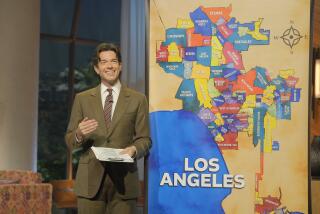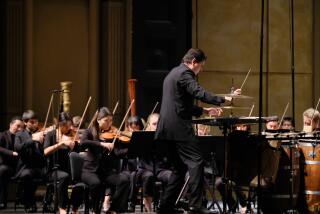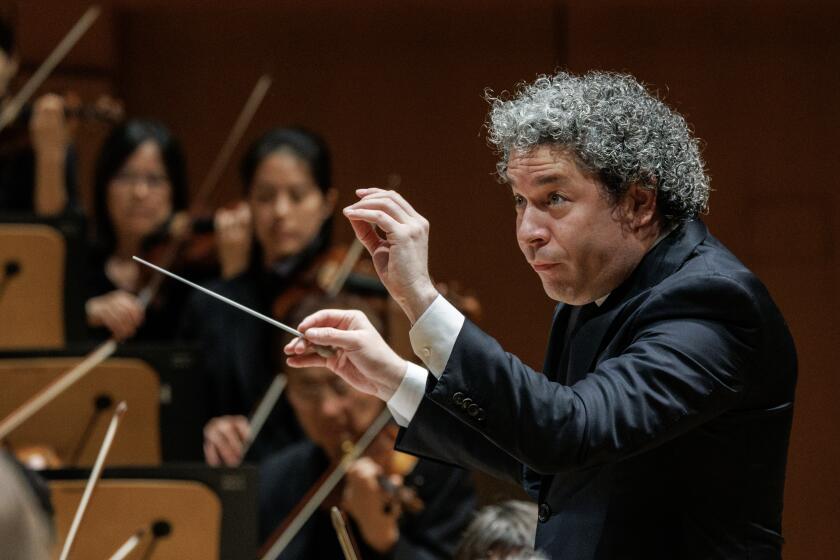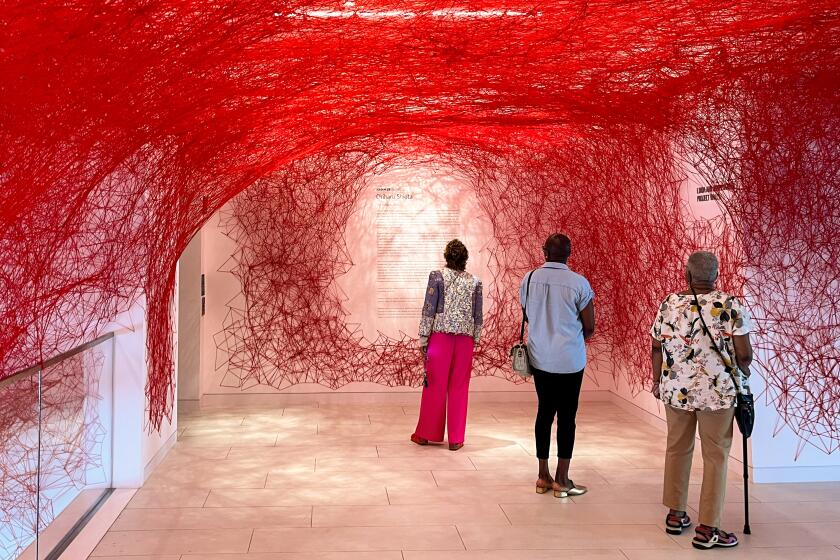How to Hamstring a Playwright
“I saw the best minds of my generation destroyed by madness.” It’s been exactly 30 years since Allen Ginsberg wrote those words. I have felt of late that our theater could use a little madness. I feel that I am watching the best minds of my generation being destroyed by logic .
There is an irony in the fact that as new-play programs continue to proliferate, the script itself seems to be the theatrical component that is trailing the pack. Performance art and the “high concept” production of classics have richly amplified the aural and visual components of theater, helping us transcend the relatively recent notion of “real rooms, actual sounds and natural light.” In most cases, however, our playwrights have not made their language rise to the occasion.
We continue to subsist on that good old realistic dialogue that the small minds in the theater value as gold. Not even a set with obtuse shapes, neon light and a throbbing synthesizer score dislodges our dependence on realistic language. The designers on such a project may have succeeded, but the playwright, in all likelihood, has given us a grocery list.
And, more to the point, we probably demand it of him/her. The words of illumination, the dangerous cadences, most certainly the poetry, have fallen helplessly into the stage manager’s wastebasket as the playwright ruminates on the comment made at one of his/her first public readings: “Your characters don’t talk like real people . At least not like anyone I know.”
Dutifully, the playwright scribbles this comment on a legal pad and that is that. Another new voice is slaughtered. Another mad writer tamed.
Who workshops lighting plots? Who dramaturgs ground plans? Designers of all kinds, formally trained or not, put their faith in effects . And well they should. These artists make empty space valuable. We set them loose to shape the theatrical arena in a way that will have an intended, if not always definable, effect on an audience.
In most new-play development programs, however, we preoccupy our playwrights with cause .
What causes this character to do this monologue at this point in the play? (“I love the writing, you understand. But it just doesn’t fit the character’s emotional logic .”)
What caused you to end Act I that way? (“I love the way she storms out of the room, but where is she going ? I’m afraid we’ll lose her through-line .”)
And here’s my personal favorite: “I think Joe’s speech to the audience is a bit bald , a bit too direct . I think the stage time would be better spent giving us some insight into the early years of their marriage. I’m not looking for explanations , you understand, I’m just curious about how he and Cindy met.”
That’s not text. That’s homework. Often I think the perfect play to hand the lazy director goes like this: CauseCauseCauseCauseCauseCauseCauseBLACKOUT. There must be no effect that cannot be traced to and overwhelmed by a cause.
The defense of this method, of course, is that it helps “flesh out the character.” In most cases, homogenize would be a better word. Consistency has never produced a memorable character. Contradiction has. Flirt with madness. Bring us some effects.
So, what are the playwright’s weapons? Poetry, action and story seem to me to be the most at risk, the most in danger of being “developed to death.” A popular new-play comment is: “In listening to your play, I became too aware of the poetry.”
But the theater’s first language is poetry, not prose, and to think otherwise is to sever our ties with greatness. Months ago I heard a director tell a young playwright: “You should listen to the way ordinary people really talk. As David Mamet does.” But Mamet is not a tape recorder. Mamet is a poet. If people actually talked--day after day--like the characters in Mamet’s plays, it would cost you $12.50 to get into Chicago.
Today’s plays of action--those that move freely through time and space and dirty up Aristotle’s theories--generally encounter the following comment at some point in their development: “What I think you have here is not a play. It’s a film. It’s too expansive for a play.”
This implies that the things we used to do very well in the theater (action, suspense, surprise, journey) are now the province of the Tube ‘n’ Screen. It implies that the theater should content itself with being home to character studies, not adventures.
But the fact is that the Tube ‘n’ Screen does miniaturizations (war, breath spray, new cars, John Hinckley, beer, bigotry, mink coats, famine--they’re all the same size), while the theater does magnifications. Because of its immediacy, the theater prioritizes the world, while the Tube ‘n’ Screen, under the guise of offering limitless opportunities, actually homogenizes it.
When it deals in action, the theater creates a desire to grapple with the world; the Tube ‘n’ Screen, while promoting passivity, creates an ongoing need for itself. I’m tired of giving our best ideas to the Tube ‘n’ Screen. We must restake our claim to adventure. Nothing moves faster than the theater.
The resurgence of story, from Spalding Gray to Emily Mann to August Wilson to Len Jenkin, is one of the few hopeful signs of life we have in today’s theater. But the well-made story must not be confused with the well-made script. They are worlds apart.
We accept that there are innumerable ways to construct a memorable story. We have Tolstoy, Twain, Woolf, Salinger et al. to tempt us with the enormity of the spectrum. I can count on one hand, however, the times I’ve heard a director or dramaturge tell a playwright that he or she has “innumerable ways” to tell a play’s story. Instead, the playwright’s vision must somehow fit into a form that is recognizable and comfortable to the new-play team.
And that form is the staged reading, a form completely distinct from the theater as we know it. Some of the most memorable times I’ve spent in the theater in the past five years have been at staged readings of new plays. Yet many of these plays, viewed later in full production, do not begin to match the magic of their script-in-hand predecessors.
The reason is simple. Our playwrights have, with the adaptability of cockroaches, learned to write brilliantly to fit the form --and in today’s theater, more often than not, the given form is not production. We have a wealth of these well-made scripts because we have a wealth of staged-reading writers. But the demands of a full dramatic event, and the text which galvanizes it, will never be codified to fit a workshop and will never be reduced to fit a staged reading.
We must empower our playwrights to challenge, not placate, directors. We must enable our playwrights to educate, not emulate, dramaturges. The stage most certainly has its limits, but our writers should be grappling with the limits of production , not of development .
Granted, readings can be valuable in realizing a playwright’s theatrical aims, and some very good plays have been born out of the reading/workshop/staged-reading process.
What I am warning against is a growing trend in conferences and new-play programs to formularize the development of plays. If said play fits the formula, great. But I fear that some of our truly unique voices are lost because their plays do not fit the formula. Consequently, we are cultivating apprentices, not artists.
If we do not recognize that by using a formula to develop plays we will get formula plays; if we settle for a theater of cause instead of a theater of effect; if we use workshops and staged readings not as a rehearsal tactic , but as a hurdle to production --if we do those things, we will get the theater we deserve. We will never get a “Hamlet.” And that will be not only our loss, but our legacy.
More to Read
The biggest entertainment stories
Get our big stories about Hollywood, film, television, music, arts, culture and more right in your inbox as soon as they publish.
You may occasionally receive promotional content from the Los Angeles Times.






